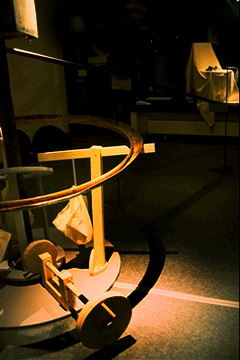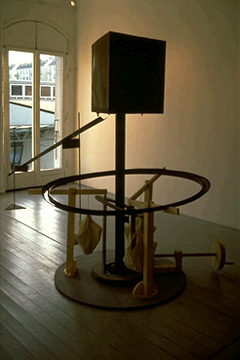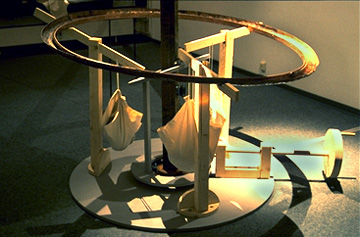

Copper, wood, steel, audio, mixed media
Macintosh computer. 1992.


The installation is concerned with the phenomenon of our existence in time and
space: how often do we become aware of where we are at the moment? —— and if we should
be in one place bodily, but in another in our minds, where are we exactly? —— in
what relation do we stand to time and space?
The installation consists of three related parts, each of which takes up a different
way of experiencing time and space.
A triangular steel tank filled with water stands atop a column; water drips out of
a valve on the tank and into a trough that traverses the space of the gallery, flowing
down the trough and out through a pipe that penetrates the wall. Outside it drips
onto the sidewalk, runs into a storm sewer, flows from there into a nearby stream
on its way to the sea. (In the case of the Hannover installation, the water flowed
over a hundred miles through various streams, into the Weser River, past Bremen and
into the North Sea.) This dripping water creates, during the course of the exhibition,
a continuously growing conceptual line of water drops between the visitors in the
gallery and the ocean.
In counterpoint to this representation of a linear conception of time and space is
a cyclical concept, manifested in the installation by a circular copper trough surrounding
the column supporting the triangular tank. Visitors may turn the handle of a wooden
crank, connected via a wooden axle to a sandstone drive wheel, thus setting in motion
an awkward, rumbling wooden mechanism which tips the copper trough so that the water
in it flows in a circle. Once per revolution, a switch is tripped which causes a
computer to play back through a small loudspeaker on the piece one of a number of
sounds stored on its hard disk. These are sentences or sound collages having to do
with cyclically occurring events, some banal, some important: the seasons, daily
rhythms, the flow of money through many hands, the rise and fall of one violent dictator
after another all through history.
A third part consists of a set of headphones and a chair draped with raw canvas. Visitors may sit on the chair and don the headphones; when they do, they hear an actor’s voice speaking one of a number of short narratives which seek to transport the listener into another place and time, be it childhood, adolescence, or an ominously empty city street at night. At the end of each text, the listener is jerked back into the present, thus re-establishing distance between the imagined state and the present moment and place.